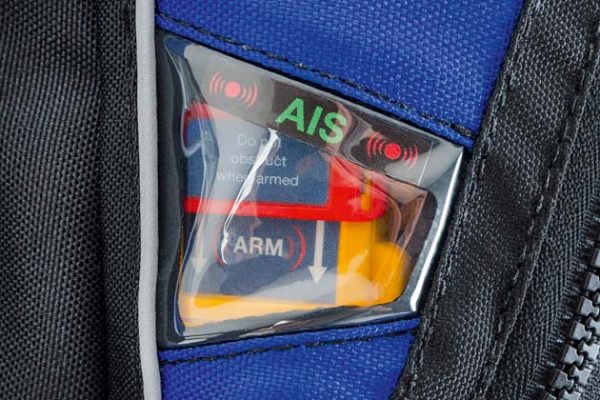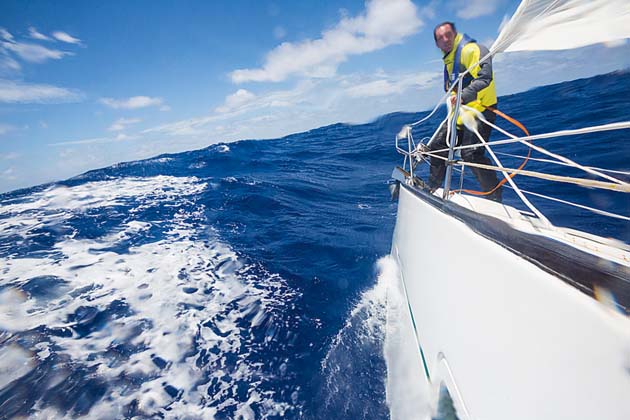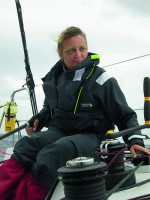Man overboard practice is more important than ever when you’re sailing short-handed and one person is left alone on board, says Pip Hare
A man overboard is every double-handed crew’s nightmare; with only one pair of hands left on board to call for help, handle sail, get back to the casualty and then recover them to the deck, it is essential your boat is well prepared and as co-skippers you have talked through and practised your manoeuvres.
Without doubt the best safety advice is to stay on board, but should the worst happen, wearing a well-fitted lifejacket with crotch straps, a light and a sprayhood is essential.
First and foremost, clip on when you are alone on deck, when you go forward or if you are sleeping on the rail. If you have an open transom, ensure your tether is short enough to prevent the helmsman from washing out of the back of the boat with any big waves.
I usually leave a spare tether of the right length in place at the helm to clip in and out of easily.
Make your co-skipper aware
Let your co-skipper know if you are going forward, or planning any other manoeuvres alone – even if you are not physically asking for their help, just knowing they are awake and will be aware if anything happens to you is an essential part of staying safe.
There are alerting devices which can set off an audible alarm below decks should one of you fall over the side. The NKE autopilot remote control will tack the boat if the MOB connection is broken and there are a great number of personal AIS devices that are either semi-automatic or automatically activated.

These can create audible alarms on AIS and VHF and will give you tracking information to get back to your co-skipper in the water.
Time and money invested in setting up the right system for your boat and becoming proficient at using it could be well spent.
If one of you does fall over the side then call for outside help immediately. If the rescue services are a long way off there may be other vessels in the area that can come and help with a search.
Even if your co-skipper is wearing a personal tracking device, press the MOB button on your GPS and record your position.
Systems on deck
Ideally you should be able to call for help, record your position, start the engine and track a man overboard without the need to go below. This may not need a complete rewire; investigate wireless options and handheld devices.

Getting back to your co-skipper as quickly as possible is the next main focus. Under white sails alone the RYA method of tacking immediately to a hove-to position will at least slow down your progress away from the target while you think through your plan. Do use your engine, but be aware of trailing ropes fouling the prop.
Talk through an MOB under spinnaker before you start any race – how quickly can one person get it down; in the worst case would it be possible to ditch all lines, cut the halyard and lose the sail without then getting tangled in lines?
These are tough questions and the answers will differ depending on your set-up and the conditions, but if sailing even at a modest eight knots under spinnaker you will cover over 240m in just one minute.
Quick tips
- Wi-fi enabled instruments will allow AIS tracking on iPads from the cockpit, which avoids having to install extra screens.
- Keep a stash of light sticks in your pocket – you can throw them over the side to make a trail to sail back along.
- Handheld VHFs now come with in-built GPS and are fully DSC functional. Having one of these at the steering position would allow you to record your position and call for help on the same device. Carrying one of these is now a requirement for RORC events.
- Practise with man overboard recovery devices, make sure you know how to rig them up and that all the bits are easily to hand.
- Invest in a set of knee pads and crawl in rough conditions when you leave the cockpit, keeping your centre of gravity low so you are less
likely to fall.

Single-handed ocean sailor Pip Hare has clocked up thousands of miles racing and cruising. Among her achievements are five solo transatlantics, including the OSTAR and two Mini Transat races. She also works full-time for the RNLI on sea safety and is Consulting Editor on Yachting World. See her gear test on weather routeing packages
See also Pip’s fascinating series on advanced sailing techniques: SAIL FASTER SAIL SAFER




